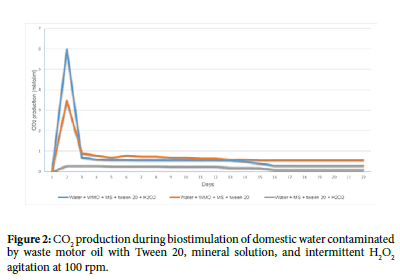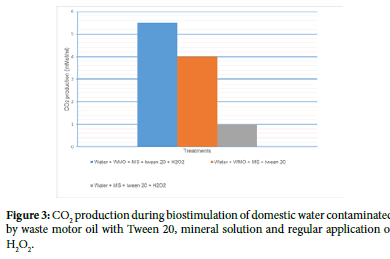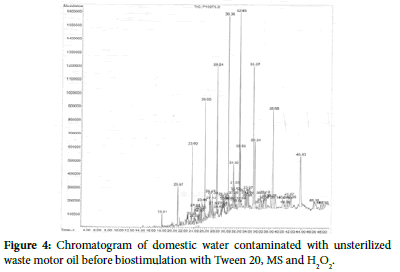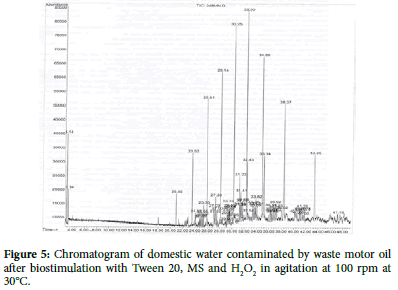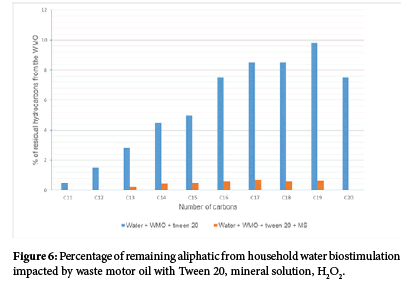Integral Biostimulation of Water Impacted by 10,000 ppm of Waste Motor Oil
Received: 03-Aug-2020 / Accepted Date: 21-Aug-2020 / Published Date: 28-Aug-2020 DOI: 10.4172/2155-6199.1000477
Abstract
An environmental problem in Mexico and the world, is the domestic water pollution or wastewater with hydrocarbon derivatives, such as waste motor oil, a hazardous waste according to Ley General de Equilibrio Ecológico y Protección Ambiental and Mexican norms NOM-001-SEMARNAT-1996, NOM-002-ECOL-1997 and NOM-003-ECOL-1997, which set maximum allowable limits of concentration: 25 ppm of hydrocarbons for discharges of wastewater and national assets, 75 ppm of wastewater to urban sewage systems and 15 ppm for treated wastewater for public reuse, respectively, that when complying with these concentration values, prevent the treatment of such domestic water. An alternative solution is biostimulation, with detergent, minerals, and oxygen that induce the aerobic heterotopic microbial population of the water, to eliminate waste motor oil and its reuse. The objective of this work was the biostimulation of domestic water contaminated by waste motor oil and to decrease it to a value lower than the maximum of Mexican norms. For this purpose, the water impacted by waste motor oil was diluted and biostimulated with the detergent Tween 80, a mineral solution and hydrogen peroxide or oxigen through the response variables: i) production of carbon dioxide by waste motor oil mineralization, ii) determination of the decrease in waste motor oil concentration, by mass-coupled gas chromatography and by Soxhlet, the experimental data were analyzed by Tukey. The results indicate that the biostimulation of the water impacted by waste motor oil with the detergent Tween 80, mineral solution and hydrogen peroxide reduced it to a value of 10 ppm, a value lower than that established by the NOM-001, NOM-002 and NOM-003, which was derived from the mineralization of waste motor oil and which showed evidence of its disappearance according to the analysis by chromatography. The above showed the biorecovery of water contaminated by waste motor oil.
Keywords: Bioremediation; Hydrocarbons; Mineralization; Water
Introduction
In Mexico, waste motor oil (WMO), a product of the petrochemical industry, is a mixture of hydrocarbons (HYCO): linear aliphatic, branched and polycyclic aromatics [1]. WMO is generated during the lubrication cycle of automobile engines, which when not properly disposed of by garages that change the oil [2], throw it into the drainage system and prevent its treatment for reuse [3], causing environmental pollution, in part because some components of WMO are toxic to all life forms [4]. By impacting surface water and aquifers, WMO violates the Ley General de Equilibrio Ecológico y Protección Ambiental (LGEEPA), which classifies it as a hazardous waste; specifically in domestic water according to regulations: NOM-001-SEMARNAT-1996, NOM-002- ECOL-1997 and NOM-003-ECOL-1997. The spillage of WMO into the drainage system is an environmental problem because the treatment plants do not solve it, and it is important because of the growing scarcity of water for and industrial use and garden irrigation, since by exceeding concentrations of: 25 ppm for discharges of wastewater and national assets, 75 ppm for wastewater to urban sewage systems, and 15 ppm for treated wastewater for public reuse, they contaminate it and it is impossible to reuse it. An alternative solution to reverse the environmental damage is biostimulation (BIS) of water polluted by WMO. The first factor required in the BIS of water polluted by WMO is a detergent that emulsifies the HYCO, followed by BIS with a mineral solution (M)S, to enrich it with essential minerals of: N (nitrogen), P (phosphorus), K (potassium), so that native microorganisms mineralize the WMO [5]. In general, BIS from water impacted by HYCO with MS is useful for eliminating petroleum derivatives, but it is relatively little known [6] and limited, in aquatic environments, simultaneously with BIS with O2 (oxygen) for maximum oxidation of WMO [5], since WMO mineralization is better and greater in aerobic conditions [7]. In nature, specifically in water, the mineralization of aromatic HYCO is complicated and slow [8,9]. Therefore, the objective of this work was the integral BIS of domestic water to eliminate WMO at a value lower than those established by NOM-001, NOM-002 and NOM-003.
Materials and Methods
Integral biostimulation of domestic water impacted by WMO
For this test, 500 ml Bartha flasks were used, with 100 ml of WMO (obtained from an oil change workshop in Morelia, Mich, Mexico) diluted 1:100, equivalent to 10,000 ppm biostimulated with 0.01% Tween 20 and a mineral solution (MS) (g/L): K2HPO4: 5; KH2PO4: 4; MgSO4: 3; NH4NO3: 10; CaCO3: 1; KCl: 2; ZnSO4: 0.5; CuSO4: 0.5; FeSO4: 0.2, and EDTA 8. The flasks were shaken at 100 rpm and incubated at 30 ± 2ºC/3 weeks, the experiment was performed in triplicate. As relative control was used: a flask with domestic water impacted by diluted WMO without biostimulant; as absolute control a flask with distilled water, biostimulated with Tween 20 and the MS; as sterile control a flask with sterile water (121°C/15min), with Tween 20, impacted by WMO biostimulated with the MS. As treatment 1 a flask with domestic water impacted by WMO, biostimulated with Tween 20 and MS; as treatment 2 a flask with domestic water impacted by WMO, biostimulated with Tween 20, MS and H2O2, as shown in Table 1. To demonstrate the mineralization of WMO in the biostimulated water, 10 ml of 0.1N KOH was added to each of the arms of the flask to capture the CO2, every 24 h the 0.1N KOH was taken from each flask, the production of CO2 being quantified by titration with 0.1N HCl [10].
| Variables | Treatments | ||||||
|---|---|---|---|---|---|---|---|
| Water | 1 | Relative control 1 | Sterile control | Absolute control 1 | 2 | Relative control 2 | Absolute control 2 |
| WMO* | * | * | * | * | |||
| Sterile WMO | * | ||||||
| Destilled water | * | * | |||||
| Mineral solution** | * | * | * | * | * | * | |
| Tween 20: 0.01% | * | * | * | * | * | * | * |
| Shaking: 100 rpm | * | * | * | * | * | * | * |
| H2O2: 25 ppm | * | * | |||||
| *WMO: Waste Motor Oil **Mineral solution (MS) g/l: K2HPO4: 5; KH2PO4: 4; MgSO4: 3; NH4NO3: 10; CaCO3: 1; KCl: 2; ZnMgSO4: 0.5; CuMgSO4: 0.5; FeMgSO4: 0.2 and EDTA 8 Tukey (p<0.05) was used to validate the results |
|||||||
Table 1: Experimental design for the biostimulation of domestic water impacted by waste motor oil, with Tween 20, enriched with a mineral solution and H2O2 in agitation.
Quantification of WMO aliphatic hydrocarbons in biostimulated domestic water
In wastewater impacted by WMO biostimulated with Tween 20, MS, with H2O2 was observed by GC-MS analysis, as well as by the Soxhlet method. A Hewlett-Packard (Waldbroon, Germany) 6890 series gas chromatograph coupled with a 5792 A series mass spectrophotometer was used, with a 30 m long HP-5MS capillary column with an internal diameter of 0.25 mm and a film thickness of 0.25 mm, the injection was split mode, the carrier gas was Helium, with a flow rate of 37 cm/ sec-1, the oven temperature was 40º C / 8min, with an increase to 180º C / 6º C min-1 and the injector temperature was 250ºC [11].
Results and Discussion
Figure 1 shows the production of CO2 during BIS of domestic water with Tween 20, MS and H2O2 in agitation, where the mineralization of ARA was observed, measured indirectly by the increase in CO2 concentration, with a maximum of 3.5 mmoles/mL at 24 h. The above result supports that, in water, the limiting factor of WMO oxidation was the nutritional imbalance, which, in balance, allows the various aerobic heterotrophic populations to eliminate in a relatively short time, most of the aliphatic WMO, which according to the analysis by Soxhlet was 10 ppm, a value lower than the maximum accepted by NOM-001, NOM-002 and NOM-003.
This was confirmed with the ARA impacted water experiment in which, without BIS with MS, where heterotrophic water consortia were unable to mineralize the WMO HYCO, consequently, CO2 production was minimal. While it is demonstrated that the disappearance of WMO is due to the activity of aerobic heterotrophic microorganisms, since the sterilization of domestic water eliminated the microorganisms and thus totally suppressed the production of CO2, despite the BIS with MS; according to statistical analysis, the values of CO2 in the water impacted with WMO were statistically different, since the biostimulation of water with MS showed that the nutritional factor is limiting or essential in the bioremediation of water with WMO. In contrast to the test where the domestic water impacted by WMO, only biostimulated with Tween 20, without the MS, proved that the detergent, was responsible only for the solubility of WMO, where without the BIS with the MS, there was no increase in the production of CO2, in this case only evidence of the mineralization of WMO. A critical aspect in the analysis of these results is the lack of information in the literature regarding water contaminated by WMO. Therefore, the data shown in this research are among the few that support the bioremediation of domestic water as a feasible strategy for its reuse. One related research is on bioremediation impacted by WMO that reported a 92.5% disposal rate [12].
WMO: Waste motor oil, Dil. 1:100, biostimulated with MS: mineral solution, Tween 20 0.01% Temperature: 30 ± 2ºC. Shaking: 100 rpm. Different letters are statistically significant, equal letters with no statistical difference (Tukey: P<0.05%).
Figure 2 shows that water BIS with MS, and with H2O2, which by increasing the concentration of available O2 for a longer time and reducing rapid volatilization (Kunucku, 2017), induced increased WMO mineralization and simultaneously increased CO2 production, to a value of 5. 88 mMoles/ml at 24 h; compared to domestic water with WMO biostimulated with MS; but without H2O2, there aerobic heterotrophic microorganisms without sufficient O2 generated less CO2, with 3.5 mMoles/mL; (Figure 3), indicating that, being aerobic mineralization, H2O2 is a limiting factor for the efficient removal of WMO.
WMO: waste motor oil, MS: mineral solution *Dil. 1:100 (10,000 ppm) Temperature: 30 ± 2ºC. Shaking: 100 rpm. Different letters are statistically significant, equal letters with no statistical difference (Tukey: P<0.05%).
WMO: Waste Motor Oil, MS: Mineral Solution *Dil. 1:100 (10,000 ppm) Temperature: 30 ± 2ºC. Shaking: 100 rpm. Different letters are statistically significant, equal letters with no statistical difference (Tukey: P<0.05%).
Figure 4 shows the chromatographic profile of domestic water impacted by WMO biostimulated with Tween 20, MS, H2O2 and 100 rpm agitation, where it was observed that the dominant aliphatic HYCO of WMO were of 11-20 carbon chains, as well as the domestic water used as absolute control, in which, the concentration of the aliphatic HYCO of WMO was similar (data not shown).
Figure 5 shows the BIS of domestic water impacted by the WMO with Tween 20, MS and H2O2 where 100% of aliphatic 11,12 and 20 carbon chain HYCO were removed, contrary to what is reported in the literature which indicates that the lower carbon chain HYCO are the first to oxidize, since short chain alkanes mineralize faster than long chain ones [13]. This supports that in domestic water impacted by WMO, the wide diversity of aerobic heterotrophic microorganisms eliminated 96% of the WMO aliphatics constituted by 13-19 carbons, according to the chromatographic analysis after the biostimulation of domestic water with Tween 20, MS, H2O2, were responsible for the mineralization of the different WMO aliphatics.
According to the Soxhlet analysis, the final concentration of the HYCO of the WMO was close to 10 ppm, below the maximum permissible limits of NOM-001, NOM-002 and NOM-003, which demonstrated the recovery of this water to be reused for garden and industrial irrigation. A critical aspect for the discussion of these results was the lack of specific information in the literature associated with the bioremediation of domestic water contaminated by WMO. In general, to solve a problem of this type, bioaugmentation with previously selected collection microorganisms is used because they mineralize the WMO aliphatics, exclusively in the culture medium, relatively few in an environment close to what happens in the wastewater [14].
Figure 6 shows the chromatogram of the biostimulation of domestic water contaminated by WMO with Tween 20, MS and H2O2, in 100 rpm agitation at 30°C on the mineralization of aliphatics with carbon chains between (C11-C20). This indicates that the aerobic heterotrophic microbial consortiums existing in domestic water, eliminated them in 96% in the 21 days of the experiment, while it was detected the elimination in 100% of the short chain aliphatic HYCO: undecane, dodecane, contrary to what was detected for the aliphatic WMO of C13-C19 in a residual concentration of 4% at the end of the experiment [15-19].
These results indicate something similar to what was reported by Hassanshahian et al., in 2014, which proved that seawater bioaugmentation impacted by 1000 ppm of oil with Alcanivorax borkumensis 95% mineralization. In the same way as Gopinath et al. demonstrated that bioaugmentation of water contaminated by HYCO with Bacillus sp and achieved a reduction to 92.5%.
WMO: waste motor oil, MS: mineral solution
Conclusion
The results of this research support that it is possible to apply the strategy of recovery of black water impacted by WMO is the integral BIS through actions of restitution of the chemical-physical environment to induce the microorganisms to oxidize the WMO that eliminate their main aliphatic and aromatic HYCO that allow the industrial and/or reactive reuse.
Acknowledgement
We would like to thank Project 2.7 (2020) of CIC-UMSNH, BIONUTRA, SA de CV Maravatio, Mich, Mexico for the support.
References
- Dike BU, Okoro BC, Nwakwasi NN, Agbo KC (2013) Remediation of used motor engine oil contaminated soil: A soil washing treatment approach. J Civil Environ Eng 3: 1-3.
- Ramadass K., Megharaj M, Venkateswarlu K, Naidu R (2018) Bioavailability of weathered hydrocarbons in engine oil-contaminated soil: Impact of bioaugmentation mediated by Pseudomonas spp. on bioremediation. Scie of The To Envit, 636: 968-974.
- Bhattacharya M, Biswas D (2014) Enhancement of waste engine oil biodegradation by optimization of media using factorial design study. IndJBiotec 13: 293-300.
- Bakke T, Klungsøyr J, Sanni S (2013) Environmental impacts of produced water and drilling waste discharges from the Norwegian offshore petroleum industry. Mari Envir Rese 92: 154-169.
- Abdulkarim A, Bello A, Abdulsalam S, Umar S, Sadiq M (2019) Bioremediation of soil contaminated with spent motor oil. J Mol Pat.
- Margesin R, Schinner F (2001) Bioremediation (Natural attenuation and Biostimulation) of diesel-oil contaminated soil in an alpine glaciar skiing area. Appl Environ Microbiol67: 3127-3133
- McIntosh P, Schulthess CP, Kuzovkina YA, Guillard K (2017) Bioremediation and phytoremediation of total petroleum hydrocarbons (TPH) under various conditions. Inter J Phytore 19: 755-764.
- Hassanshahian M, Emtiazi G, Caruso G, Cappello S (2014) Bioremediation (bioaugmentation/biostimulation) trials of oil polluted seawater: Amesocosm simulation study. Mari Envirresea 95: 28-38.
- Huang X, Zhou H, Liang Y, Li Y, Xie Q, et al. (2020) Enhanced bioremediation of hydraulic fracturing flowback and produced water using an indigenousbiosurfactant-producing bacteria acinetobacter sp. Y2. ChemEnginJ 397: 125348.
- Celis H, Machuca H, Sandoval E, Morales C (2011) Biological activity in a degraded alfisol amended with sewage sludge and cropped with yellow serradela (Ornithopuscompressus L.). Chile J of Agric Rese 71: 164-172.
- Plohl K, Leskovsek H, Bricelj M (2002) Biological degradation of motor oil in water. ActaChimSlov 49: 279-289.
- Gopinath SM, Shareef MI, Ashalatha, Ganessin A (2015) Bioremediation of lubricant oil pollution in water by Bacillus megaterium. Int. J Innov Res in SciEng Tech 4: 6773-6780.
- Birch H, Hammershøj R, Comber M, Mayer P (2017) Biodegradation of hydrocarbon mixtures in surface waters at environmentally relevant levels-effect of inoculum origin on kinetics and sequence of degradation. Chemosphe 184: 400-407.
- Basuki W, (2017) Biodegradation of used synthetic lubricating oil by Brevundimonasdiminuta AKL 1.6. Mak J of Scie 21: 136-142.
- Norma Oficial Mexicana NOM-001-ECOL-1996, Queestablece los lÃmitesmáximospermisibles de contaminantes en lasdescargas de aguasresiduales en aguas y bienesnacionales, publicada en el DiarioOficial de la Federación el 6 de enero de 1997.
- Norma Oficial Mexicana NOM-002-ECOL-1996, Queestablece los lÃmitesmáximospermisibles de contaminantes en lasdescargas de aguasresiduales a los sistemas de alcantarilladourbano o municipal, publicada en el DiarioOficial de la Federación el 3 de junio de 1998.
- Norma Oficial Mexicana NOM-003-ECOL-1997, Queestablece los lÃmitesmáximospermisibles de contaminantesparalasaguasresidualestratadasque se reusen en servicios al público, publicada en el DiarioOficial de la Federación el 14 de enero de 1998.
- SEMARNAT (Secretaria del MedioAmbiente y RecursosNaturales) Ley General del EquilibrioEcológico y Protección al Ambiente. 1996.
- Kunukcu YK, (2007) In-situ bioremediation of groundwater contaminated with petroleum constituents using oxygen release compounds (ORCs). J EnvirScieHeaPart A 42: 839-845.
Citation: Garcia-Hernandez D, Márquez-Benavides L, Saucedo-Martínez, Sanchez-Yanez JM (2020) Integral biostimulation of water impacted by 10,000 ppm of waste motor oil. J Bioremediat Biodegrad 11: 477. DOI: 10.4172/2155-6199.1000477
Copyright: © 2020 García-Hernández D, et al. This is an open-access article distributed under the terms of the Creative Commons Attribution License, which permits unrestricted use, distribution, and reproduction in any medium, provided the original author and source are credited.
Share This Article
Recommended Journals
Open Access Journals
Article Tools
Article Usage
- Total views: 2083
- [From(publication date): 0-2020 - Apr 03, 2025]
- Breakdown by view type
- HTML page views: 1326
- PDF downloads: 757


